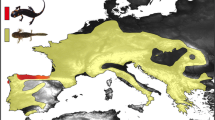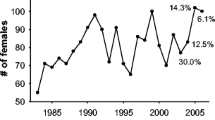Abstract
Both modelling and field data from three breeding seasons show that an environmental factor, clutch loss (CL), affects the operational sex ratio (OSR) and therefore male mating frequency in strawberry poison frogs. Clutch loss affects the length of reproductive cycles of both sexes: with increasing clutch losses, males spend proportionately more time than females in parental investment activities. Because of this, males spend relatively less time in the mating pool, i.e. exhibit proportionately more “time-out” than females in comparison to a situation with low or no clutch loss. Hence, clutch loss leads to a less male-biased OSR, coupled with a decrease in the opportunity for sexual selection. Furthermore, this study resolves an apparent paradox, the negative correlation between mating frequency and reproductive success (=number of produced tadpoles) of individual males in one breeding season. Clutch loss decouples the correlation between mating frequency and reproductive success because females re-enter the mating pool when they lose their offspring. However, clutch loss diminishes the reproductive output. Similar consequences of clutch loss on the OSR may be true for many species where both sexes reproduce frequently in one breeding season.


Similar content being viewed by others
References
Ahnesjö I (1995) Temperature affects male and female potential reproductive rates differently in the sex-role reversed pipefish Syngnathus typhle. Behav Ecol 6:229–233
Aichinger M (1987) Annual activity patterns of anurans in a seasonal neotropical environment. Oecologia 71:583–592
Almada VC, Goncalves EJ, Oliviera RF, Santos AJ (1995) Courting females: ecological constraints affect sex roles in a natural population of the blenniid fish Salaria pavo. Anim Behav 49:1125–1127
Arnold SJ, Wade MJ (1984) On the measurement of natural and sexual selection: theory. Evolution 38:709–719
Breitburg DL (1987) Interspecific competition and the abundance of nest sites: factors affecting sexual selection. Ecology 68:1844–1855
Brust DG (1993) Maternal brood care by Dendrobates pumilio: a frog that feeds its young. J Herpetol 27:96–98
Bush S (1993) Courtship and male parental care in the Majorcan midwife toad, Alytes muletensis. PhD Thesis, University of East Anglia
Clutton-Brock TH, Parker GA (1992) Potential reproductive rates and the operation of sexual selection. Q Rev Biol 67:437–456
Clutton-Brock TH, Vincent ACJ (1991) Sexual selection and the potential reproductive rates of males and females. Nature 351:58–60
Donnelly MA, Guyer C (1994) Patterns of reproduction and habitat use in an assemblage of Neotropical hylid frogs. Oecologica 98:291–302
Emlen ST, Oring LW (1977) Ecology, sexual selection, and the evolution of mating systems. Science 197:215–223
Forsgren E, Kvarnemo C, Lindström K (1996) Mode of sexual selection determined by resource abundance in two sand goby populations. Evolution 50:646–654
Forsgren E, Amundsen T, Borg ÅA, Bjelvenmark J (2004) Unusually dynamic sex roles in a fish. Nature 429:551–554
Gwynne DT, Simmons LW (1990) Experimental reversal of courtship roles in an insect. Nature 346:172–174
Haase A, Pröhl H (2002) Female activity patterns and aggressiveness in the strawberry dart-poison frog Dendrobates pumilio (Anura: Dendrobatidae). Amphib Reptil 23:129–140
Kruse KC (1990) Male backspace availability in the giant waterbug (Belostoma flumineum Say). Behav Ecol Sociobiol 26:281–289
Kvarnemo C (1994) Temperature differentially affects male and female reproductive rates in the sand goby: consequences for OSR. Proc R Soc Lond Ser B 256:151–156
Kvarnemo C (1998) Points of view: why male cannibalism won’t cause a female biased OSR—a comment on Smith and Wootton’s paper. Rev Fish Biol Fish 8:93–98
Kvarnemo C, Ahnesjö I (1996) The dynamics of operational sex ratio and competition for mates. Trends Ecol Evol 11:404–408
Kvarnemo C, Simmons LW (1998) Male potential reproductive rate influences mate choice in a bushcricket. Anim Behav 55:1499–1506
Kvarnemo C, Svensson O, Forsgren E (1998) Parental behaviour in relation to food availability in the common goby. Anim Behav 56:1285–1290
Major RE (1991) Breeding biology of the white-fronted chat Ephthianura albifrons in a saltmarsh near Melbourne. Emu 91:236–249
Manica A (2002) Filial cannibalism in teleost fish. Biol Rev 77:261–277
Martinez MI, Huerta C, Magdalena CR (1996) Female reproductive behaviour of Copris incertus Say (Coleptera, Scarabeidae). Bull Soc Entomol Fr 101:121–130
Neff BD (2003) Paternity and condition affect cannibalistic behavior in nest-tending bluegill sunfish. Behav Ecol Sociobiol 54:377–384
Parker GA, Simmons LW (1996) Parental investment and the control of sexual selection: predicting the direction of sexual competition. Proc R Soc Lond Ser B 263:315–321
Pröhl H (1997) Patrón reproductivo en Dendrobates pumilio (Anura: Dendrobatidae). Rev Biol Trop 45:1671–1676
Pröhl H (2002) Population difference in female resource abundance, adult sex ratio and male mating success in Dendrobates pumilio. Behav Ecol 13:175–181
Pröhl H (2003) Variation in male calling behaviour and its influence on male mating success in the strawberry poison frog (Dendrobates pumilio). Ethology 109:273–290
Pröhl H, Hödl W (1999) Parental investment, potential reproductive rates and mating system in the strawberry poison-dart frog Dendrobates pumilio. Behav Ecol Sociobiol 46:215–220
Smith C, Wootton RJ (1995) The effect of brood cannibalism on the operational sex ratio in parental teleost fishes. Rev Fish Biol Fish 5:372–376
Smith C, Wootton RJ (1998) Points of view: cannibalism and OSR—a response to Kvarnemo. Rev Fish Biol Fish 8:99–100
Tallamy DW, Denno RF (1982) Life history trade-offs in Gargaphia solani (Hemiptera: Heteroptera: Tingidae): the cost of reproduction. Ecology 63:616–620
Trivers RL (1972) Parental investment and sexual selection. In: Campbell BG (ed) Sexual selection and the descent of Man. Aldine-Atherton, Chicago, pp 136–179
Verhulst S, Hut RA (1996) Post-fledging care, multiple breeding and the cost of reproduction in the great tit. Anim Behav 51:957–966
Wade MJ, Arnold SJ (1980) The intensity of sexual selection in relation to male sexual behaviour, female choice, and sperm precedence. Anim Behav 28:446–461
Weygoldt P (1980) Complex brood care and reproductive behaviour in captive poison arrow frogs, Dendrobates pumilio O.Schmidt. Behav Ecol Sociobiol 7:329–332
Zar JH (1999) Biostatistical analysis, 4th edn. Prentice Hall, New Jersey
Acknowledgements
I thank Anne Houde, R.D. Howard, Marko Spieler, Diana Hews and the Ryan-Lab, especially Karin Pfennig, Mike Ryan and Molly Cummings, and three anonymous reviewers for critical comments on various versions of the manuscript. I am grateful to the government of Costa Rica for providing the necessary research permit (SINAC permit no. 133-96-OFAU and 166-97-OFAU), and to the German Academic Exchange Service (DAAD) for supporting my field studies in Costa Rica.
Author information
Authors and Affiliations
Corresponding author
Additional information
Communicated by J. Christensen-Dalsgaard
Rights and permissions
About this article
Cite this article
Pröhl, H. Clutch loss affects the operational sex ratio in the strawberry poison frog Dendrobates pumilio. Behav Ecol Sociobiol 58, 310–315 (2005). https://doi.org/10.1007/s00265-005-0915-9
Received:
Revised:
Accepted:
Published:
Issue Date:
DOI: https://doi.org/10.1007/s00265-005-0915-9




